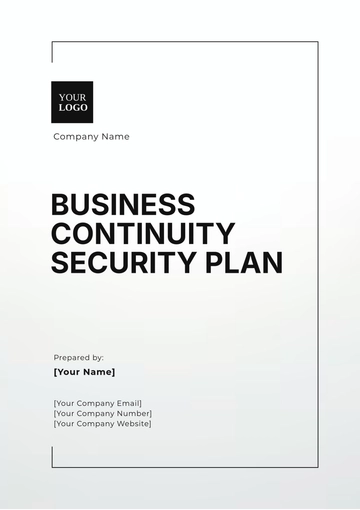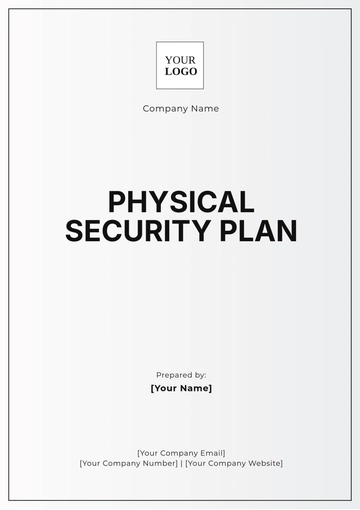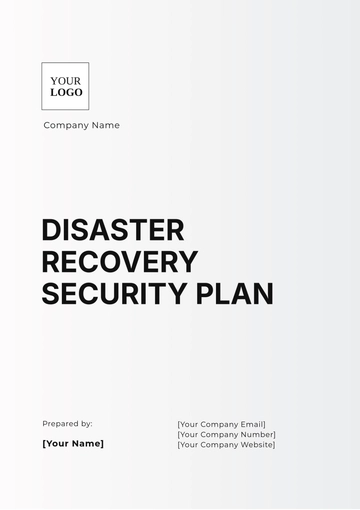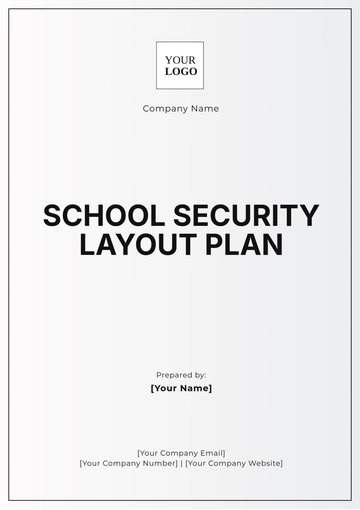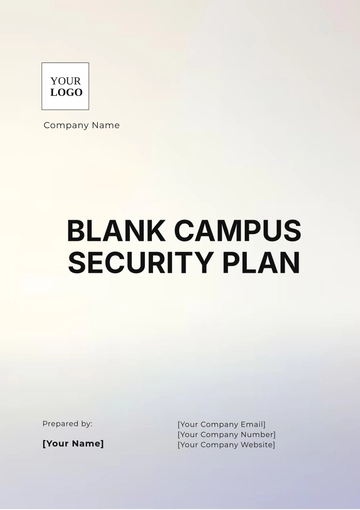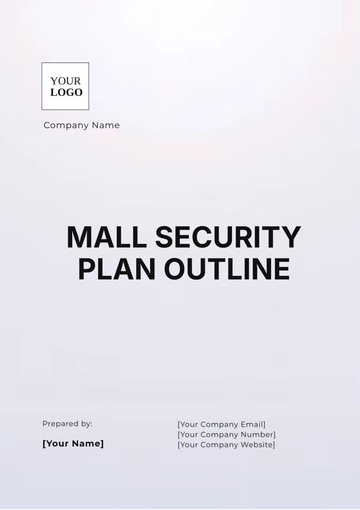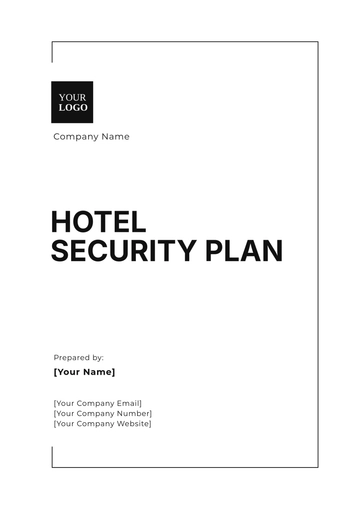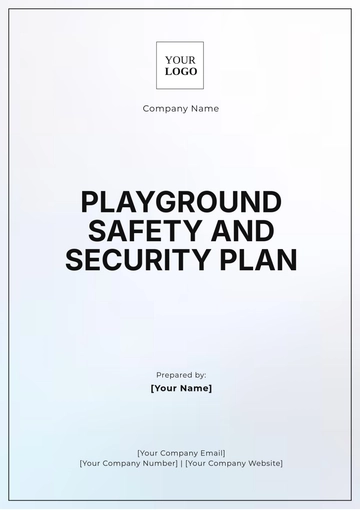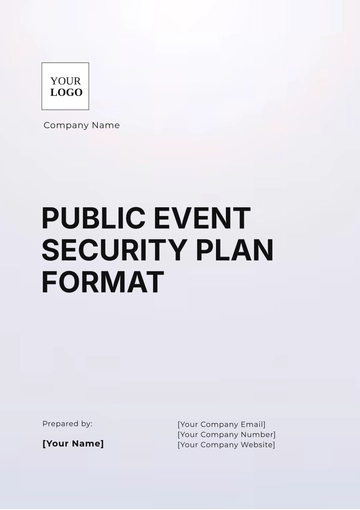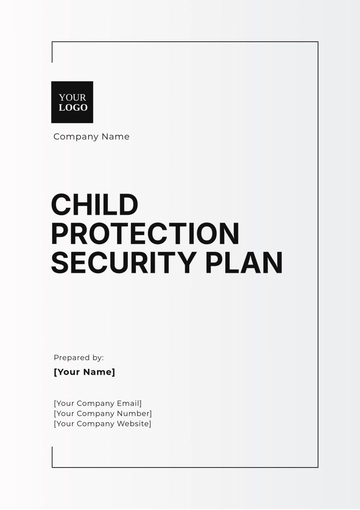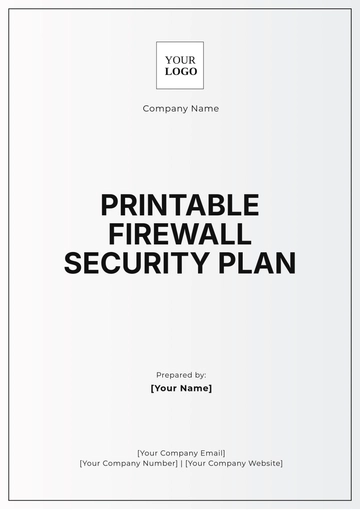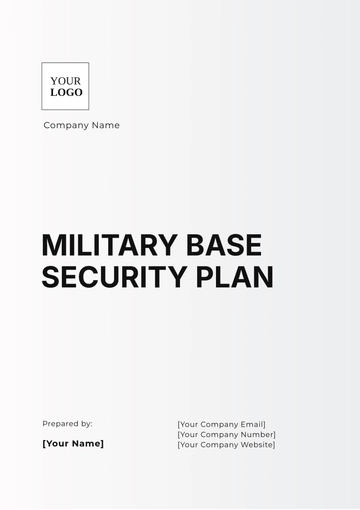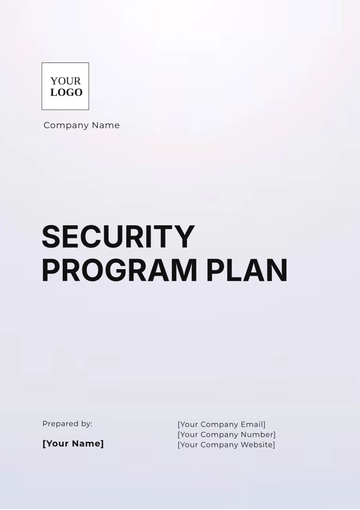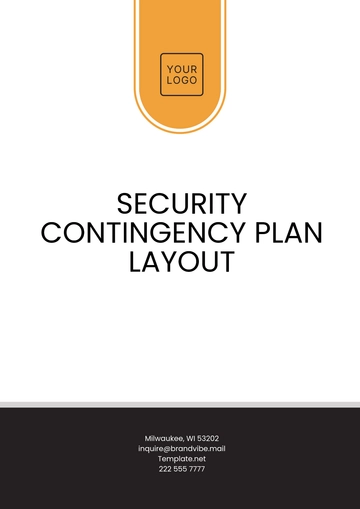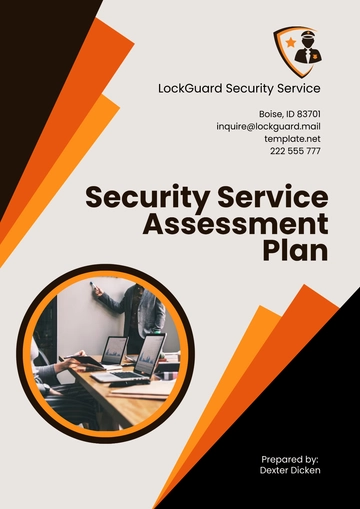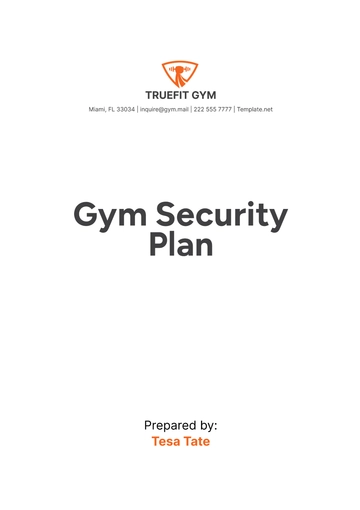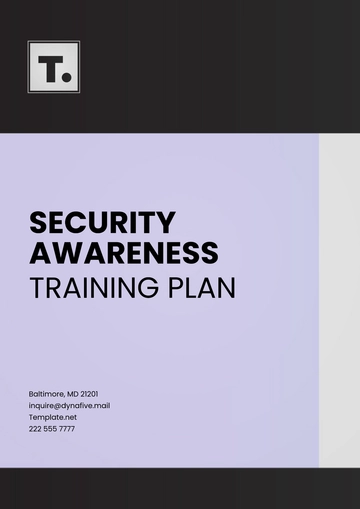Free Blank Campus Security Plan
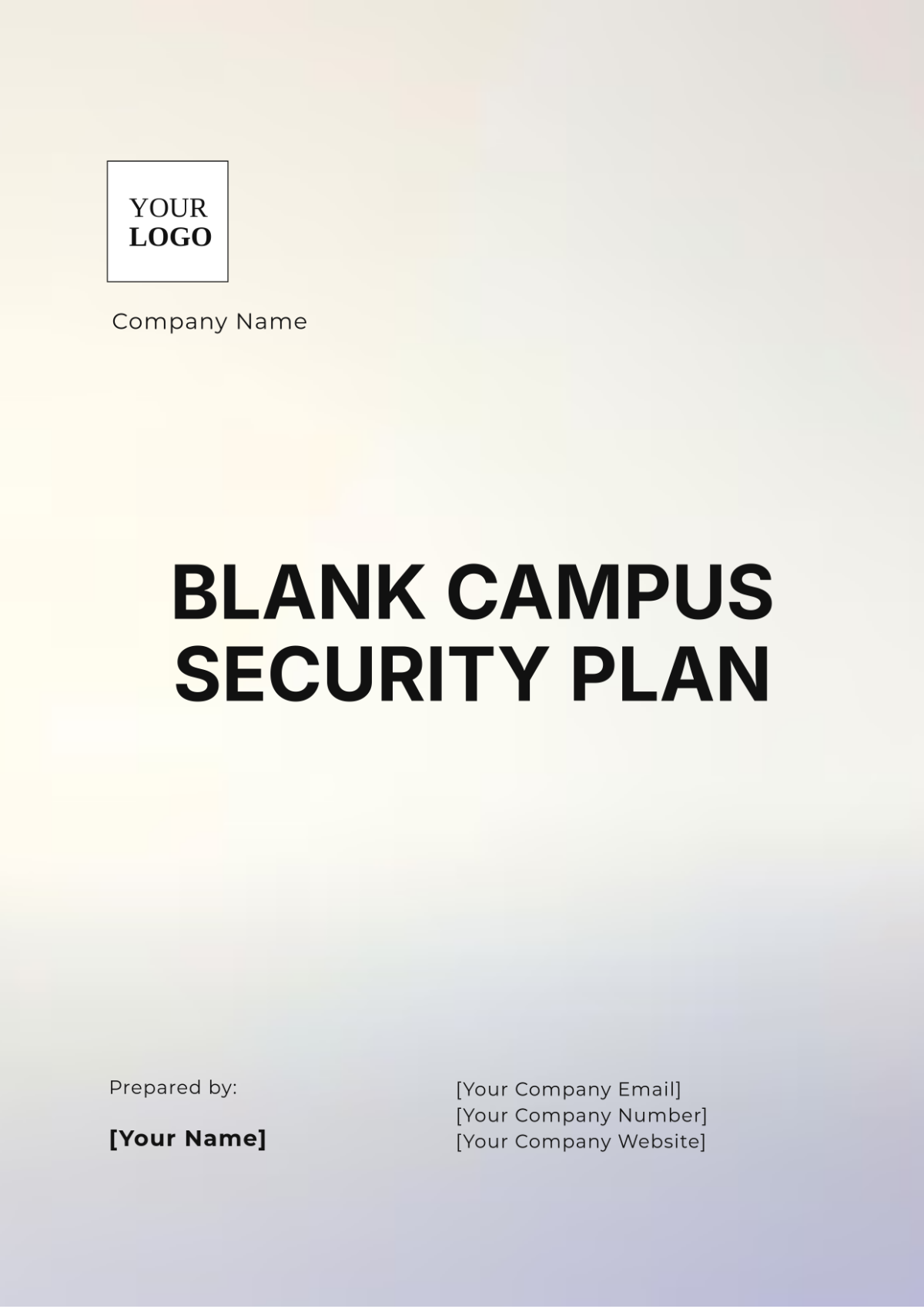
I. Introduction
This Campus Security Plan outlines comprehensive strategies and measures designed to ensure the safety, security, and preparedness of our campus community. By addressing potential risks and defining the roles and responsibilities of security personnel and departments, this document serves as a roadmap for creating a secure and conducive educational environment. The plan emphasizes proactive measures and fosters a culture of safety awareness among students, faculty, and staff.
II. Objectives
The primary objectives of the Campus Security Plan are:
Safeguard the Campus Population: Protect students, faculty, staff, and visitors from various threats, including violence, theft, and other criminal activities.
Protect Property and Information Resources: Ensure the security of physical assets and sensitive information by implementing appropriate safeguards and access controls.
Establish Protocols for Emergencies and Crises: Develop clear and actionable procedures for responding to emergencies, including medical emergencies, natural disasters, and security threats.
Promote a Culture of Vigilance and Readiness: Encourage all campus members to remain aware of their surroundings and report suspicious activities, fostering a proactive approach to campus safety.
III. Security Management Structure
1. Security Personnel and Responsibilities
The security management structure consists of a well-defined hierarchy to ensure effective oversight and response. Key roles include:
Chief Security Officer (CSO): Responsible for overall security strategy, policy development, and coordination with local authorities.
Security Managers: Oversee daily operations, manage security personnel, and ensure compliance with safety protocols.
Security Guards: Patrol the campus, monitor surveillance systems, respond to incidents, and assist in enforcing campus policies.
Emergency Response Team (ERT): A trained group responsible for handling emergencies and crises, including first aid and evacuation procedures.
2. Coordination with Local Authorities
This plan emphasizes the importance of collaboration with local law enforcement, fire departments, and emergency medical services. Regular meetings and joint training exercises will enhance communication and ensure rapid response during emergencies. Memorandums of understanding (MOUs) with these agencies will facilitate information sharing and coordination of resources.
IV. Risk Assessment and Mitigation
1. Risk Identification
A thorough risk assessment process involves:
Surveys and Assessments: conducting regular surveys of the campus environment to identify vulnerable areas.
Incident Reports: Analyzing past incidents to recognize patterns and areas for improvement.
Stakeholder input: engaging students, faculty, and staff to identify perceived risks and concerns.
2. Risk Mitigation Strategies
Risk | Strategy |
|---|---|
Unauthorized Access | Implement advanced card access systems, biometric readers, and extensive surveillance cameras throughout campus buildings and entry points. |
Vandalism | Increase campus lighting in high-risk areas, implement community watch programs, and deploy routine patrols during peak hours. |
Natural Disasters | Conduct regular emergency drills for natural disasters, maintain stocked emergency kits in strategic locations, and establish a clear evacuation plan. |
V. Emergency Preparedness
1. Emergency Response Procedures
Develop comprehensive emergency response procedures tailored to specific scenarios, including:
Fire: Establish evacuation routes, fire extinguisher locations, and training on fire alarm protocols.
Severe Weather: Implement procedures for severe weather alerts, shelter-in-place protocols, and communication with the campus community.
Active Shooter: Create a detailed active shooter response plan, including lockdown procedures, communication protocols, and safe evacuation routes.
2. Communication Plan
A robust communication strategy is vital for effective information dissemination during emergencies. This includes:
Multi-Channel Alerts: Utilizing emails, text alerts, and campus loudspeakers to reach the community quickly.
Crisis Communication Team: A dedicated team to manage communications and updates during an emergency situation.
VI. Security Awareness and Training
1. Security Education Programs
Implement ongoing security education programs that cover:
Workshops and Seminars: Offer sessions on personal safety, situational awareness, and reporting procedures for suspicious activities.
Resource Materials: Distribute brochures, flyers, and digital resources outlining security tips and emergency procedures.
2. Drills and Simulations
Conduct periodic drills and simulations to evaluate the effectiveness of security protocols, including:
Fire Drills: Regular fire evacuation drills to ensure all community members are familiar with procedures.
Active Shooter Simulations: Training sessions to prepare students and staff for potential active shooter scenarios, involving role-playing and scenario-based learning.
VII. Continuous Improvement
1. Monitoring and Review
Establish a routine for reviewing and updating the security plan, ensuring it remains effective and relevant by:
Annual Assessments: Conducting annual assessments of security measures and policies in light of new threats or changes in campus dynamics.
Technology Upgrades: evaluating and incorporating new security technologies as needed.
2. Feedback Loop
Create channels for collecting feedback from campus stakeholders, ensuring that security measures remain effective and responsive to community needs. This includes:
Surveys and Feedback Forms: Regularly distributing surveys to gather input on security perceptions and areas for improvement.
Campus Security Forums: Hosting forums or town hall meetings to facilitate open dialogue about security concerns and solutions.
- 100% Customizable, free editor
- Access 1 Million+ Templates, photo’s & graphics
- Download or share as a template
- Click and replace photos, graphics, text, backgrounds
- Resize, crop, AI write & more
- Access advanced editor
The customizable Blank Campus Security Plan Template offered by Template.net is designed to help you create a comprehensive security plan with ease. This downloadable and printable template ensures your campus remains safe and secure. It's fully editable in our AI Editor Tool, allowing you to tailor the plan to your specific needs while saving time and effort.
You may also like
- Finance Plan
- Construction Plan
- Sales Plan
- Development Plan
- Career Plan
- Budget Plan
- HR Plan
- Education Plan
- Transition Plan
- Work Plan
- Training Plan
- Communication Plan
- Operation Plan
- Health And Safety Plan
- Strategy Plan
- Professional Development Plan
- Advertising Plan
- Risk Management Plan
- Restaurant Plan
- School Plan
- Nursing Home Patient Care Plan
- Nursing Care Plan
- Plan Event
- Startup Plan
- Social Media Plan
- Staffing Plan
- Annual Plan
- Content Plan
- Payment Plan
- Implementation Plan
- Hotel Plan
- Workout Plan
- Accounting Plan
- Campaign Plan
- Essay Plan
- 30 60 90 Day Plan
- Research Plan
- Recruitment Plan
- 90 Day Plan
- Quarterly Plan
- Emergency Plan
- 5 Year Plan
- Gym Plan
- Personal Plan
- IT and Software Plan
- Treatment Plan
- Real Estate Plan
- Law Firm Plan
- Healthcare Plan
- Improvement Plan
- Media Plan
- 5 Year Business Plan
- Learning Plan
- Marketing Campaign Plan
- Travel Agency Plan
- Cleaning Services Plan
- Interior Design Plan
- Performance Plan
- PR Plan
- Birth Plan
- Life Plan
- SEO Plan
- Disaster Recovery Plan
- Continuity Plan
- Launch Plan
- Legal Plan
- Behavior Plan
- Performance Improvement Plan
- Salon Plan
- Security Plan
- Security Management Plan
- Employee Development Plan
- Quality Plan
- Service Improvement Plan
- Growth Plan
- Incident Response Plan
- Basketball Plan
- Emergency Action Plan
- Product Launch Plan
- Spa Plan
- Employee Training Plan
- Data Analysis Plan
- Employee Action Plan
- Territory Plan
- Audit Plan
- Classroom Plan
- Activity Plan
- Parenting Plan
- Care Plan
- Project Execution Plan
- Exercise Plan
- Internship Plan
- Software Development Plan
- Continuous Improvement Plan
- Leave Plan
- 90 Day Sales Plan
- Advertising Agency Plan
- Employee Transition Plan
- Smart Action Plan
- Workplace Safety Plan
- Behavior Change Plan
- Contingency Plan
- Continuity of Operations Plan
- Health Plan
- Quality Control Plan
- Self Plan
- Sports Development Plan
- Change Management Plan
- Ecommerce Plan
- Personal Financial Plan
- Process Improvement Plan
- 30-60-90 Day Sales Plan
- Crisis Management Plan
- Engagement Plan
- Execution Plan
- Pandemic Plan
- Quality Assurance Plan
- Service Continuity Plan
- Agile Project Plan
- Fundraising Plan
- Job Transition Plan
- Asset Maintenance Plan
- Maintenance Plan
- Software Test Plan
- Staff Training and Development Plan
- 3 Year Plan
- Brand Activation Plan
- Release Plan
- Resource Plan
- Risk Mitigation Plan
- Teacher Plan
- 30 60 90 Day Plan for New Manager
- Food Safety Plan
- Food Truck Plan
- Hiring Plan
- Quality Management Plan
- Wellness Plan
- Behavior Intervention Plan
- Bonus Plan
- Investment Plan
- Maternity Leave Plan
- Pandemic Response Plan
- Succession Planning
- Coaching Plan
- Configuration Management Plan
- Remote Work Plan
- Self Care Plan
- Teaching Plan
- 100-Day Plan
- HACCP Plan
- Student Plan
- Sustainability Plan
- 30 60 90 Day Plan for Interview
- Access Plan
- Site Specific Safety Plan


